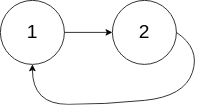有赞&leetcode141:判断一个单链表是否有环
sisterAn opened this issue · comments
给定一个链表,判断链表中是否有环。
为了表示给定链表中的环,我们使用整数 pos 来表示链表尾连接到链表中的位置(索引从 0 开始)。 如果 pos 是 -1,则在该链表中没有环。
示例 1:
输入:head = [3,2,0,-4], pos = 1
输出:true
解释:链表中有一个环,其尾部连接到第二个节点。示例 2:
输入:head = [1,2], pos = 0
输出:true
解释:链表中有一个环,其尾部连接到第一个节点。示例 3:
输入:head = [1], pos = -1
输出:false
解释:链表中没有环。进阶:
你能用 O(1)(即,常量)内存解决此问题吗?
附leetcode地址:leetcode
当然是让引擎帮你判断啦
function hasLoop(node){
try{
JSON.stringify(node)
}catch(e){
return e.toString().includes('Converting circular')
}
return false
}哈哈哈开玩笑的,其实可以用 Map 或者快慢指针解
解法一:标志法
给每个已遍历过的节点加标志位,遍历链表,当出现下一个节点已被标志时,则证明单链表有环
let hasCycle = function(head) {
while(head) {
if(head.flag) return true
head.flag = true
head = head.next
}
return false
};时间复杂度:O(n)
空间复杂度:O(n)
解法二:利用 JSON.stringify() 不能序列化含有循环引用的结构
let hasCycle = function(head) {
try{
JSON.stringify(head);
return false;
}
catch(err){
return true;
}
};时间复杂度:O(n)
空间复杂度:O(n)
解法三:快慢指针(双指针法)
设置快慢两个指针,遍历单链表,快指针一次走两步,慢指针一次走一步,如果单链表中存在环,则快慢指针终会指向同一个节点,否则直到快指针指向 null 时,快慢指针都不可能相遇
let hasCycle = function(head) {
if(!head || !head.next) {
return false
}
let fast = head.next.next, slow = head.next
while(fast !== slow) {
if(!fast || !fast.next) return false
fast = fast.next.next
slow = slow.next
}
return true
};时间复杂度:O(n)
空间复杂度:O(1)
哈希map
init一个WeakMap用来存放已经遍历的链表,判断如果不存在set, 如果存在则是循环引用
var hasCycle = function(head) {
let map = new WeakMap()
if (!head && !head.next) {
return false
}
while (head) {
if (map.get(head)) {
return true
} else {
map.set(head, false)
head = head.next
}
}
return false
};function Node(data) {
this.data = data
this.next = null
}
const node1 = new Node(1)
const node2 = new Node(2)
const node4 = new Node(4)
const node6 = new Node(6)
const node3 = new Node(3)
const node5 = new Node(5)
const node9 = new Node(9)
node1.next = node2
node2.next = node4
node4.next = node6
node6.next = node5
node5.next = node9
node9.next = node6
let hasCycle = function (head) {
if (!head || !head.next) {
return false
}
let fast = head.next.next,
slow = head.next
let i = 0
while (fast !== slow) {
if (!fast || !fast.next) {
return false
}
fast = fast.next.next
slow = slow.next
i++
}
return true
}
const hasCycle2 = (head) => {
try {
JSON.stringify(head)
return false
} catch (error) {
console.log(error)
return true
}
}
const hasCycle3 = (head) => {
let link = head
while (link) {
if (link.flag) return true
link.flag = true
link = link.next
}
return false
}
var a = hasCycle3(node1)

